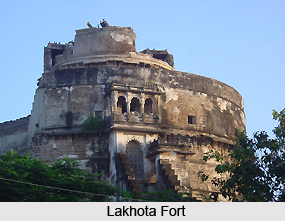 Leisure tourism in Jamnagar District, Gujarat permits its visitors to admire the many thrilling tourism centers based here, which include the wonderful palaces, forts and several other ancient historical monuments which are found in this region.
Leisure tourism in Jamnagar District, Gujarat permits its visitors to admire the many thrilling tourism centers based here, which include the wonderful palaces, forts and several other ancient historical monuments which are found in this region.
Darbargadh Palace
Also referred to as `Maharaja`s Palace`, Darbargadh Palace used to be the old dwelling place of Jam Sahebs and its interiors boast of a fascinating fusion of European and Rajput style of architectural patterns. It is said to be one of the most important historical structure in this district and contains jewelled mirrors, fretwork `jali screens`, wall paintings, carved pillars and beautiful sculpture. Venetian-Gothic arches and a carved gate are the other attractions of this palace.
Pratap Vilas Palace
Pratap Vilas Palace was constructed during the reign of King Ranjit Singh and reflects a unique blend of European and Indian architecture. Equipped with Indian carvings, this palace was created as a resemblance of Victoria Memorial, Kolkata, though its domes follow the pattern of Indian architecture. Three of the domes are made of glass.
Lakhota Fort
This fort-like palace is present in the middle of Lakhota Lake and is believed to have belonged to the Maharaja of Nawanagar. Musket loops, turrets, powder flasks, various kinds of swords, semi-circular bastions and a beautifully arched balustrade which joins the palace with the district. An abundant quantity of sculptures belonging to the 9th and 18th century, as well as pottery works existent in demolished ancient villages are present in the fort museum.
 Willingdon Crescent
Willingdon Crescent
Maharaja Ranjit Singh had built the Willingdon Crescent, which consists of cusped arches, particularly on the ground floor and upper storey. Pilasters on its curved walls and parapates adorned with balusters are the special attractions of this building. At the central part of the crescent, a statue of Jam Saheb is existent.
Dhanvantri Mandir Gujarat Ayurved University
The Dhanvantri Mandir was created under the supervision of the Chief Medical Officer of Guru Govindsingh Hospital named Dr. Pranjivan Manekchand Mehta. This structure received the prestigious status of a university, known as Ayurveda University following the independence of India. It is a significant centre of research which also houses a workshop and library.
Bhujio Kotho
This historical monument is located near Khambhaliya Gate, on the banks of Lakhota Tank and is immensely popular amongst travellers, mainly due to its height. It possesses five storeys and had been built for the purpose of safeguarding against foreign invasions. The first floor of Bhujio Kotho contains guns and holes have been made in the walls to store the rifles. A tank is present on the upper floor to preserve water and a dancing peacock was kept on top of it.
Bohra Hajira
The Bohra Hajira is present on the banks of Nagmati and Rangmati Rivers and falls on the route which leads to the Rajkot Highway. However, one must obtain prior permission from the office in its premises in order to pay a visit to Bohra Hajira. Previously, boats used to sail on the rivers Nagmati and Rangmati but since the waters of these rivers have dried up now, fairs during the month of `Shravan` are arranged here.
There are certain other leisure tourism centres in the district of Jamnagar which involve Kotha Bastion and the Solarium. Copper plates, coins, several masterpieces of sculpture, the skeleton of a whale, inscriptions and coins are part of the several artefacts displayed in Kotha Bastion. The Solarium was constructed by Jam Shri Ranjitsinhji and is also termed as the Ranjit Institute of Poly-Radio Therapy. This tower is a slowly revolving one which was earlier utilized for the treatment of skin diseases. It is exposed to sunlight for the entire day. Currently, however, it is not used anymore as it has become obsolete.



















